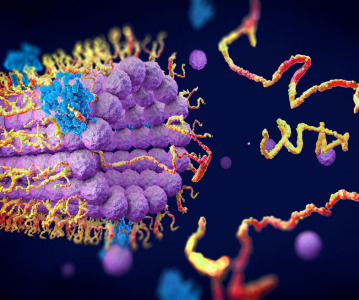Targeting Pharmacoresistant Epilepsy and Epileptogenesis with Eslicarbazepine Acetate

In a manuscript just published in “BRAIN”, a journal of neurology, Anna Doeser et al provide evidence on how eslicarbazepine, the main active metabolite of eslicarbazepine acetate, overcomes a cellular resistance mechanism to conventional antiepileptic drugs. Furthermore, eslicarbazepine acetate showed an antiepileptogenic effect in an animal model of chronic epilepsy, likely associated with the eslicarbazepine-induced inhibition of Cav3.2 T-type Ca2+ channels, which have been shown to be key mediators of epileptogenesis.
Eslicarbazepine acetate, a once-daily antiepileptic drug, is currently approved in the European Union (Zebinix), US and Canada (Aptiom), for the adjunctive treatment of partial-onset seizures in adults.
Chronically epileptic tissue was obtained from epileptic patients that underwent brain surgery in an attempt to control their seizures and from rats with previously induced chronic epilepsy. Electrophysiological studies performed in hippocampal cells derived from those tissues showed that eslicarbazepine maintained its activity on sodium channels, with significant additional effects to carbamazepine (a classic antiepileptic drug).
The antiepileptogenic effects were tested in a standard animal model of chronic epilepsy. Eslicarbazepine acetate was transiently administered (p.o., once-daily for 6 weeks) starting nine days after induction of epilepsy in mice through the injection of pilocarpine. Control mice were administered placebo instead of eslicarbazepine acetate, during the same 6-week period. Importantly, 8 weeks after the end of treatment, mice that had received eslicarbazepine acetate showed significantly less spontaneous seizures and a pronounced reduction in neuropathology. Thus, eslicarbazepine acetate proved to be the first drug approved for use in humans that results in pronounced antiepileptogenic effects.
These findings are of critical importance because two major limitations of currently available treatments for epilepsy are that i) around one third of patients are uncontrolled despite being treated with anticonvulsant drugs and ii) currently available treatments so far act mainly by inhibiting seizure activity, but do not target the underlying disease process.
“This publication offers an explanation as to why some of the patients with resistance to carbamazepine responded to eslicarbazepine acetate in the previous phase III trials. Also of note, the authors have presented evidence that suggests eslicarbazepine acetate may have anti-epileptogenic effects, which needs of course to be confirmed in properly conducted studies in humans” commented Holger Lerche, University of Tübingen, Department of Neurology and Epileptology, Hertie-Institute of Clinical Brain Research, Germany.
“We are really excited with this groundbreaking results, obtained through a very close partnership with the Experimental Epileptology and Cognition Research group from the Life and Brain Center, University of Bonn Medical Center, led by Professor Heinz Beck”, said Professor Patrício Soares-daSilva, Head of the R&D Department at BIAL and co-author of this publication. "Bial will further evaluate, in conjunction with the scientific community and clinical epilepsy experts, the possibility and best options to further study the potential antiepileptogenic effects of eslicarbazepine acetate in humans."
Related News
-
News A Day in the Life of a Start-Up Founder and CEO
At CPHI we work to support Start-Up companies in the pharmaceutical industry and recognise the expertise and innovative angles they bring to the field. Through our Start-Up Programme we have gotten to know some of these leaders, and in this Day in the ... -
News Biopharmaceutical manufacturing boost part of new UK government budget
In their national budget announced by the UK Labour Party, biopharmaceutical production and manufacturing are set to receive a significant boost in capital grants through the Life Sciences Innovative Manufacturing Fund (LSIMF). -
News CPHI Podcast Series: The power of proteins in antibody drug development
In the latest episode of the CPHI Podcast Series, Lucy Chard is joined by Thomas Cornell from Abzena to discuss protein engineering for drug design and development. -
News Amgen sues Samsung biologics unit over biosimilar for bone disease
Samsung Bioepis, the biologics unit of Samsung, has been issued a lawsuit brought forth by Amgen over proposed biosimilars of Amgen’s bone drugs Prolia and Xgeva. -
News CPHI Podcast Series: Why we need to consider women in clinical trials
The latest episode of the CPHI Podcast Series with Lucy Chard covers women's health, specifically women's representation in clinical trials, the associated bias, and the impacts on health for this population. -
News US FDA does not approve MDMA therapy for PTSD, requests more data
The MDMA-based therapeutic developed by Lykos Therapeutics, a California-based Public Benefit Corporation (PBC), has been reviewed and unapproved by the US FDA. The regulator has requested additional phase III trial data for further safety and efficacy... -
News Novartis and Viatris latest facing lawsuit over HeLa cell misuse
Global pharmaceutical companies Novartis and Viatris are the latest hit with a lawsuit claim pertaining to alleged misuse of the ‘HeLa’ cell line from the estate of woman whose cancerous tissue cells were taken without consent. -
News Sanofi invests billions into Frankfurt insulin production site
French pharmaceutical company Sanofi have announced an investment of EUR1.3 billion at their existing BioCampus site in Frankfurt am Main for the expansion of insulin production.
Position your company at the heart of the global Pharma industry with a CPHI Online membership
-
Your products and solutions visible to thousands of visitors within the largest Pharma marketplace
-
Generate high-quality, engaged leads for your business, all year round
-
Promote your business as the industry’s thought-leader by hosting your reports, brochures and videos within your profile
-
Your company’s profile boosted at all participating CPHI events
-
An easy-to-use platform with a detailed dashboard showing your leads and performance



.png)

.png)
.png)
.png)